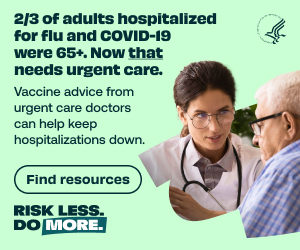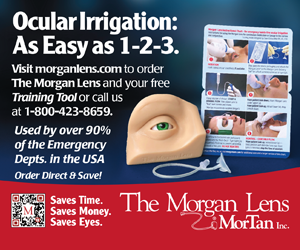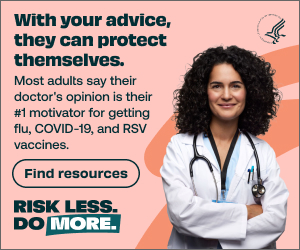
The logistics of the Drive-Through ED are straightforward, and they start as soon as the patient drives up to the emergency department. “Instead of being directed into a parking space, patients are met by a screening nurse who does a mini-triage,” says Weiss. “The nurse determines if the person is there for a flu-like illness.” If that is the case, and if the patient is stable enough, they are directed to a designated parking structure where the drive-through ED has been set up. This single step can siphon off as much as 70 percent of patients during a flu outbreak, says Weiss, leaving the emergency department free to care for more emergent cases.
Patients directed to the drive-through ED line up in a series of 4 or 5 queues, not unlike lining up for a car inspection at the DMV. In the Stanford experiment, the cars moved quickly, “much faster than patients move through the ED,” said Weiss. Security directed cars to proceed into the parking structure as spots opened up.
As patients enter the parking structure, the first stop is registration. “Someone walks up to the window, finds out how many people are wanting to be evaluated, and then they generate the chart right there,” said Weiss. During the experiment Stanford used paper charts, which could be slipped under the car’s windshield wiper. After registration, cars pull forward into a triage area where a nurse takes vital signs. “Pulse, blood pressure, oxygen saturation, respiratory rate and temperature – all that is done while the patient remains in the car,” said Weiss. Once the nurse has completed triage, he/she moves to the next car and the physician steps up, or allows the car to proceed forward to an exam area.
The physician has the option of talking to the patients through the window or having them step out of the car for an examination. “You usually need to get people out of their cars briefly to perform a comprehensive examination, but this is fairly easy,” said Weiss. “You have them sit down on a cot, stretcher or chair, and then you create an isolation area using separation screens or rolling curtains.” Once the physician has performed the necessary exams, the patient returns to the car, and the physician steps aside to chart the encounter. Once the physician has finished charting and returned the chart to the car windshield, the patient moves on to discharge. The physician moves on to the next window and the process repeats.
“We also built in an observation area to make the system more versatile,” says Weiss.. For example, if a patient has vomiting and looks mildly dehydrated, and you want to make sure that they can keep fluids down, you can write for Zofran and then the patient will drive over to an observation area where cars are parked.” During the Stanford experiment, nurses delivered medications and oral fluids to the cars in the designated observation area and kept track of each patient on a status board. “At some point the physician walks over to check on these patients in their cars, just as they would in the ED. At that point, the physician can decide to go ahead and send the patient home or they can get further lab work done or admit the patient to the ED for IV hydration. The beauty of the observation area is that, unlike the indoor ED, it doesn’t tie up exam areas for hours while patients wait for test results. Plus, there’s point-of-care blood testing that can be done right there at the car using iSTAT machines. They can check a blood sugar on a diabetic, they can check a chemistry panel, they can do a rapid INR, etc… Even EKGs can be done at the car side.” Stanford is planning to test the feasibility of bringing in portable, digital X-ray machines normally used in their trauma center. “You may be able take chest X-rays right at the car side and then read the film right on the machine.”
At discharge, a patient’s third and final stop, paperwork is handled just as it would be in a walk-through department. “In terms of reimbursement, the charts are generated, the patient gets a full medical screening, exam, triage, etc… The only difference is where the patient is seen,” said Weiss. “The physician fee, the nursing fee and the medication fees are the same.” Facility fees would be the one unknown, says Weiss, since a drive-through ED would have lower overhead than its walk-through counterpart. “In the end, it might actually save the patient money, while providing a social distancing strategy using the patient’s automobile as an isolation compartment to mitigate the person-to-person spread of infectious diseases.”
click on image to view full pdf of map

For obvious reasons, a hurdle for the drive-through emergency department is deployment in cold climates. However, there are many systems available for outdoor heating, from heating lamps used at restaurants to elaborate systems used to heat NFL benches during games in November. As long as the exam area is kept to a defined 2-4 car limit, says Weiss, heating should be manageable.
Another hurdle is simply getting emergency department personnel to accept a new treatment paradigm. “We all work indoors,” says Weiss. “We are used to going into a room, evaluating a patient and then going back to our computer terminals to write. It’s an all indoor operation. When you move it to any kind of external environment you take people out of their comfort zone.” In the Stanford experiment, however, Weiss found that emergency personnel thrived in the new environment. “Most emergency physicians are hardy individuals. They love the challenge of practicing in unorthodox, or even austere environments.”
In terms of the structure itself, while parking structures work well, it need only be covered and well ventilated. Plus, just about every community has one. Ventilation is a concern for obvious reasons, but during the Stanford trial, the parking structure proved ventilated enough that there were no significant elevations of carbon monoxide levels in the participants.
Aftermath
The results to the Stanford experiment were impressive. The mean length of stay, measured from registration time to discharge time in simulated patients during the exercise was 25 minutes in the drive-through ED, compared with 111 minutes in real patients seen with identical complaints in the regular walk-through ED, a decrease of 86 minutes.
From a patient satisfaction perspective, participants in the Stanford experiment raved about the experience, reporting that they felt significantly more comfortable and more secure than they would have in an ED waiting room. “One woman came in a pick-up truck with a camper,” says Weiss. “She said it was great because she had to bring her father who was able to lay down in the back of the camper.” Patients in general enjoyed the relative comfort of their cars, appreciating also that they didn’t have to find a parking space. Children watched DVDs while more serious patients lay down in their back seats. Patients appreciated that they could get information on wait times by tuning into a designated radio station. According to Weiss, the model was a hit for “the same reason that lots of people go through the drive-through at McDonalds. They don’t have to get out of their cars. It’s the ultimate convenience. Instead of door-to-doctor, it’s doctor-to-door.”
click on image to view high-res pdf

Despite Stanford’s best attempts to make the scenarios identical to real life, the drive-through ED was decidedly an artificial environment. The staff new that they were being timed and the “patients” were polite, well behaved, and all spoke English. It is possible that the physicians in the Drive-Through ED would not have obtained the same information in the same amount of time and come to the same disposition decisions if required to acquire the data from actual patients. These factors could have contributed to shorter lengths of stay, but could hardly have accounted for the entire 86-minute reduction in length of stay.
Since the physician evaluation times were shorter in the DTED, it is possible that the medical evaluations were either inadequate or inaccurate. To validate the efficacy of performing a medical screening exam in the DTED, the Stanford team injected 6 patients into the exercise that required admission based on pre-determined clinical pathways. Physicians in the DTED identified all six patients that were admitted in the WTED.
Again and again, studies have connected overcrowding with increased morbidity and mortality. If the drive-through emergency department can effectively alleviate an overcrowded ED, it could be useful in a variety of situations beyond a flu outbreak. It could easily be deployed during a bioterrorism event, for instance. “After the anthrax event in 2001 there were large numbers of people crowding emergency department trying to get antibiotics,” recalls Weiss. “The drive-through ED could have been used to quickly evaluate people and then dispense any medication. After the sarin attack in Tokyo, 4000 people went to emergency departments, and most of these patients were all the worried well.”
“If you have a parking structure, you have the resources,” says Weiss. “There are even large tents that you can get which would allow cars to drive right through. You can go out there with a modicum of equipment and it will unload the emergency department from so many patients. It may be the best option for surge healthcare delivery during an emerging infectious disease outbreak or bioterrorism event.”









3 Comments
What a unique idea. Great job!
Patient’s have been asking for this for along time!! BUT it just goes to prove HOW MANY use the ER for inappropriate reasons!!
That mask is insufficient to combat the poisonous gases and carcinogens spewing from car exhausts. This is a high risk environment and increases the health and risks to all. I hope real gas masks are supplied.
Other observations:
-Being in a parking lot with many sick, anxious, and frustrated people behind wheels of multi-ton vehicles sounds like a recipe for disaster. Shouldn’t there also be training on vehicle evasion techniques, perhaps provided by the military?
-Evaluating a sick person in public near their vehicle could possibly be a HIPAA violation. Will we need license plate covers like we do for charts?
-From a public safety standpoint, letting sick people drive away is fraught with danger and a possible litigation nightmare. Should we establish (double blinded) study driven “safe driving” criteria and also have a mechanism to impound someone’s vehicles if they seem too ill to drive, i.e. fever >101, pulse >120, akithesia, severe pain, etc.?
Overall an interesting idea, and I’d be interested in reading the manual that eventually gets generated with the help of this grant.